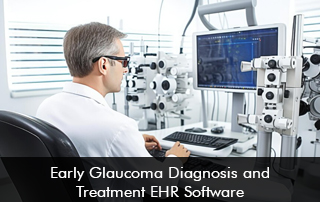Glaucoma, often referred to as the “silent thief of sight,” is a group of eye conditions that damage the optic nerve, often leading to irreversible vision loss. Early detection and treatment are crucial in managing this condition and preserving vision. Ophthalmology EHR software has revolutionized how glaucoma is diagnosed and treated, enhancing efficiency and ease for both doctors and patients.
Understanding Glaucoma
Glaucoma encompasses several conditions characterized by increased intraocular pressure (IOP), which can damage the optic nerve. The most common types are primary open-angle glaucoma and angle-closure glaucoma. Symptoms often go unnoticed until significant vision loss occurs, making early detection vital.
The Importance of Early Diagnosis
Early diagnosis of glaucoma can prevent or slow the progression of the disease. This requires regular eye exams and monitoring, which involves comprehensive documentation and analysis of patient data. This is where EHR software becomes indispensable.
The Role of EHR Software in Ophthalmology
EHR software specifically designed for ophthalmology integrates various functionalities that streamline the process of diagnosing and treating glaucoma. These systems offer numerous advantages:
Centralized Patient Data
EHR systems store all patient information, including medical history, examination results, and treatment plans, in a centralized digital format. This ensures that ophthalmologists have quick and easy access to comprehensive patient data, facilitating informed decision-making.
Enhanced Diagnostic Tools
Modern ophthalmology EHR software includes advanced diagnostic tools that aid in the early detection of glaucoma. Features like digital imaging integration, visual field testing, and optical coherence tomography (OCT) enable precise monitoring of the optic nerve and retinal nerve fiber layer, crucial for early diagnosis.
Automated Workflow
EHR systems automate various aspects of the diagnostic and treatment process. Automated reminders for regular check-ups, alerts for abnormal test results, and streamlined documentation processes reduce the administrative burden on healthcare providers, allowing them to focus more on patient care.
Decision Support Systems
EHR software often includes decision support systems that analyze patient data and provide recommendations based on established clinical guidelines. This assists ophthalmologists in making evidence-based decisions regarding the management and treatment of glaucoma.
Patient Engagement
Many EHR platforms offer patient portals that enable individuals to access their health information, review test results, and communicate with their healthcare providers. This fosters patient engagement and adherence to treatment plans, which is critical for managing chronic conditions like glaucoma.
Enhancing EHR Software Efficiency in Diagnosis
Comprehensive Documentation
EHR software allows for detailed and accurate documentation of patient encounters. Ophthalmologists can record findings from eye exams, track changes in IOP, and document visual field test results. This comprehensive documentation is essential for monitoring disease progression and making timely treatment decisions.
EHR Software Data Integration
EHR systems integrate data from various diagnostic devices, creating a cohesive patient record. For example, digital imaging tools like fundus cameras and OCT machines can directly upload images to the patient’s EHR. This eliminates the need for manual data entry and reduces the risk of errors.
Trend Analysis
EHR software can generate trend reports that track changes in a patient’s eye health over time. These reports highlight any concerning trends, such as rising IOP or deteriorating visual fields, prompting early intervention. Trend analysis is particularly useful in glaucoma management, where gradual changes can indicate disease progression.
Streamlining Glaucoma Treatment
Personalized EHR Software Treatment Plans
With EHR software, ophthalmologists can create personalized treatment plans based on individual patient data. The system can recommend appropriate medications, surgical options, or lifestyle modifications based on the patient’s specific condition and medical history. This personalized approach enhances the effectiveness of treatment and improves patient outcomes.
Medication Management
Managing medications is a critical aspect of glaucoma treatment. EHR software helps ophthalmologists keep track of prescribed medications, monitor patient adherence, and identify potential drug interactions. Automated alerts remind both the doctor and patient when it’s time for medication refills, ensuring continuous treatment.
EHR Software Coordination of Care
Glaucoma management often involves a multidisciplinary approach, including optometrists, ophthalmologists, and primary care physicians. EHR systems facilitate seamless communication and coordination among healthcare providers. Shared access to patient records ensures that all members of the care team are informed about the patient’s condition and treatment plan.
EHR Software Benefits for Patients
Improved Access to Care
EHR software improves access to care by enabling telemedicine services. Patients can have virtual consultations with their ophthalmologists, discuss their symptoms, and receive advice without needing in-person visits. This is particularly beneficial for patients with mobility issues or those living in remote areas.
Enhanced Patient Education
Patient portals provided by EHR systems offer educational resources about glaucoma, its symptoms, and treatment options. Educated patients are more likely to adhere to their treatment plans and use preventive measures, such as regular eye exams.
Real-Time Health Monitoring
Some EHR platforms include tools for remote health monitoring. Patients can use mobile apps or connected devices to measure their IOP at home, automatically uploading the data to their EHR. This real-time monitoring allows for prompt adjustments to the treatment plan if needed.







